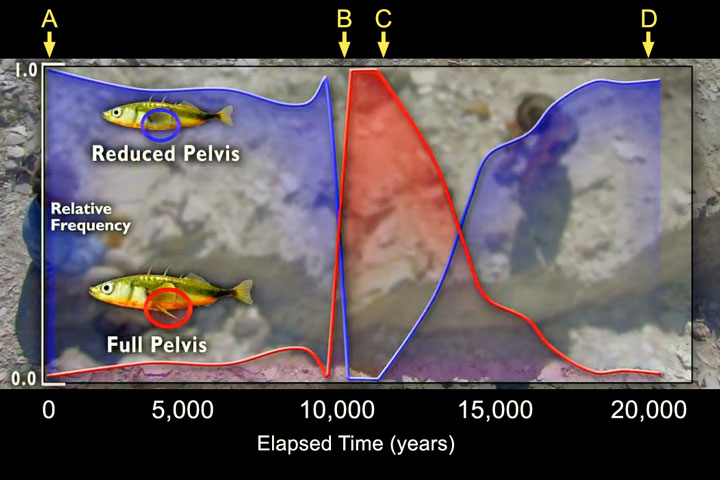Evolving Switches, Evolving Bodies Quiz Results
1. How did some stickleback populations come to live exclusively in fresh water?
- Some stickleback populations that swam to freshwater lakes to spawn (breed) got trapped at the end of the last ice age.
- Some stickleback populations that have always lived exclusively in fresh water migrated into lakes that formed at the end of the last ice age.
- Some stickleback populations evolved the traits necessary to live in freshwater environments. Afterward, they moved into lakes that formed after the last ice age.
- Some stickleback populations that swam to freshwater lakes to spawn stayed because there were no predators at the end of the last ice age.
Answers chosen:
Attempts:
2. Which of the following helps to explain why some freshwater stickleback populations lack pelvic spines?
- Pelvic spines are homologous to legs in four-legged animals, and freshwater stickleback fish don't need hind limbs to move.
- Freshwater stickleback fish have evolved different types of protective armor to keep them safe from predators.
- A marine stickleback will shed its spines when trapped in a freshwater lake.
- Although no large predatory fish live in the lakes, there are freshwater predators that grab stickleback fish by their pelvic spines.
Answers chosen:
Attempts:
3. Why did Kingsley and his team cross marine and freshwater stickleback fish?
- To find the location of the gene(s) causing the differences among stickleback populations with and without spines.
- To test whether Pitx1 is involved in the formation of pelvic spines.
- To compare the Pitx1 protein-coding sequence from fish with and without pelvic spines.
- To understand the timing of the expression of gene(s) for making pelvic spines in embryonic development.
Answers chosen:
Attempts:
4. What did researchers discover about the genetic mutation causing the loss of pelvic spines?
- It is found in the coding region of the Pitx1 gene.
- It results in a protein that is no longer functional.
- It is always found in one of the regulatory "switches" near the coding region of the Pitx1 gene.
- It occurred once and has spread to many different populations around the world by natural selection.
Answers chosen:
Attempts:

5. Bell and collaborators painstakingly documented the prevalence of stickleback fish with full and reduced pelvises over a 20,000-year fossil record. What can be concluded from their data, shown in the graph?
- Initially (time A), fish with full pelvises (red line) were most common in the lake population.
- At time B, the frequency of fish with full pelvises was very high. At time C, this population started to evolve reduced pelvises.
- In this population, having pelvic spines seems to have provided a selective advantage to stickleback fish beginning at time C.
- The evolution of pelvic reduction seen in this fossil record is different from the phenomenon occurring in the lakes of Alaska today.
Answers chosen:
Attempts:
6. Multiple lines of evidence (from the field, the fossil record, and molecular genetics) help to illustrate stickleback evolution. Which of the following statements about the data are true? Select all that apply.
- Molecular data from present-day stickleback populations are not as helpful as fossil data because evolution takes millions of years.
- Genetic evidence reveals the precise molecular mechanism responsible for the change in pelvic structures in stickleback populations.
- The fossil data show an ancient pattern of evolution that is repeating in the present day.
- Fossil data are not as helpful as molecular data from present-day stickleback populations because the fossil record is incomplete and unreliable.
Answers chosen:
Attempts: